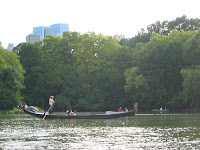
I read about touch tours at the Metropolitan Museum of Art and Museum of Modern Art over a year ago, and wanted to schedule them for a dear friend who went completely blind in 2006. The tours take place during working hours on week days and must be planned weeks in advance.
When I became unemployed, I decided to take the opportunity to finally arrange these tours.
My blind friend has struggled to regain his bearings in the world. He has a wonderful spirit, and perceives his disability as a way of engaging with the world in a new way. His attempts to navigate this altered existence are inspirational.
We had a touch tour of the Met first. Our guide, Pam, began by taking us to the new Greek and Roman galleries. My friend visited the Met when he was sighted, but had not seen the new galleries. Pam directed him to the atrium where he could feel the warmth of sun streaming through the skylight. My friend recalled that the space had formerly been a restaurant, and the guide and I described how it changed.
My friend had visited Pompeii while sighted. In fact, we discussed it a lot when I visited Naples several years ago. With this in mind, I began to describe the new gallery by drawing on his knowledge of the mosaics and architecture of Pompeii. It helped to have this visual baseline to depict through comparison a picture of something he has not yet seen.
My friend's expression changed when I told him the black and white mosaic floors were similar to the Cave Canem mosaic. He said he could picture the dog mosaic in his mind. I explained that the type of tiles used in the new gallery were almost the same as those used in the Pompeii mosaic.
We discussed the layout of the room by comparing it to the atriums he saw in Pompeii. He nodded as he recalled the skylight, impluvium (pool to collect rainwater), and columns supporting the roof. The comparison helped him envision the new space. The warm sunlight and fountain under the skylight also supported his understanding.
We then went to the Egyptian wing to begin the tour in earnest. My friend felt stone sarcophagi and statues. He enjoyed feeling the pieces because it was a new way of experiencing the art. This was a museum experience he was denied as a sighted person.
He was encouraged to first feel around the whole piece to get a sense of its scale. It also set boundaries for what was part of the artwork and what was not. Sometimes he would feel a part of a pedestal and think it was incorporated in the art.
Then, he would feel the artwork's details. Sometimes he could figure out what they were intended to show, but he often needed descriptions to clarify what he was touching. For example, he could tell the was touching the eye of Hatsheput but he didn't know that the line he touched was a depiction of her eyeliner.
Often I was made aware of details about the items he touched by hearing the questions he posed and Pam's responses. I hadn't noticed that the line he touched was eyeliner rather than the rim of the eye.
As he felt a statue of Sakhmet we had a conversation about the ancient Egyptian's depiction of negative space. Ancient sculptors had not yet figured out a way to carve stones with projecting parts (such as outstretched arms or legs). Instead, the artists recessed the stone to keep prominent arms and legs in semi-relief. My friend was able to feel this depiction of negative space. It was a revelation for him.
Several of the pieces had been repaired over the years. My friend was able to quickly discern the differences in original and restorative materials. This was a distinction that was more difficult to see than to feel.
Once the touch tour was over, we returned to the Greek and Roman galleries. He asked me to describe the Etruscan chariot to him. He had seen it long ago.
Describing the piece aloud was a task that forced me to notice the art in greater detail. As I spoke, I saw for the first time strange compositional elements and decorative repetitions within different scenes on the chariot.
The touch tour's emphasis on details made me realize how much I overlook. I am not taking full advantage of my eyesight because I filter out much of what I see.
My friend and I left the museum shortly after the chariot description. He said it was depressing to hear about art he used to see. It was only fun to be in the museum experiencing something new.
We went for a walk in Central Park and happened to pass the boathouse.
I mentioned to my friend that I had always wanted to go boating in Central Park, but had not done so.
We were in a boat within an half hour. The staff at the boathouse could not have b
 een more kind and upbeat about accommodating my friend and his guide dog.
een more kind and upbeat about accommodating my friend and his guide dog.It was a beautiful, early fall day. The lake was full of boaters.
At first I rowed because it was difficult to navigate around the many boaters. Once we reached a less crowded area, my friend took the oars. I navigated by tapping his hands to indicate which oar to row.
It was his first time rowing a boat since losing his sight. It was my first time boating in Central Park. We were both delighted to be there doing something new.
There are many ways to explore the world.



